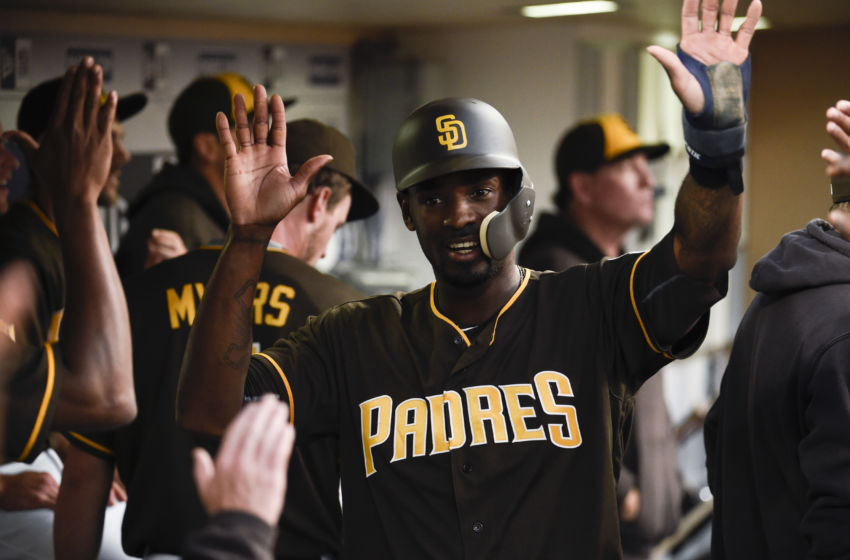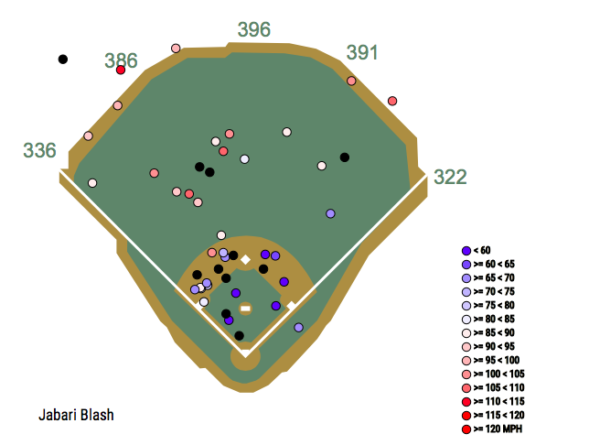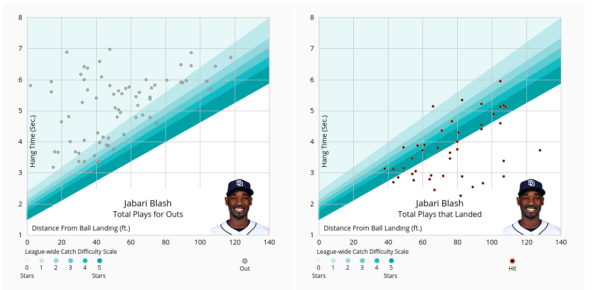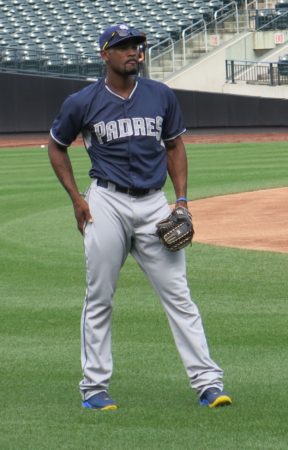PNO (Positives Negatives Outlook): Jabari Blash

Credit: AP Photo

Jabari Blash was traded to the San Diego Padres in December of 2015 by the Oakland Athletics after they claimed him off waivers from the Seattle Mariners.
Jabari made his big league debut for the Padres in April of 2016, and since then, he has been more or less an anomaly.
251 players were drafted before Jabari Blash in the 2010 June Amateur Draft, a class that has proven to be one of the best classes in recent memory.
However with Blash being the late bloomer he is, he managed to stand out on his own. A 2013 Cal Mid-Season All-Star nomination, a 2013 MiLB.com Organizational All-Star for the Seattle Mariners, and a 2015 SOU Mid-Season All-Star nomination were all accomplished by this young outfielder.
When Hunter Renfroe was optioned to Triple-A El Paso in August after failing to improve at the plate, it was Blash whom the Padres front office decided to go with to fill the hole in right field. His season was not very memorable and his future is cloudy. But here is a PNO (positives, negatives, outlook) on Jabari Blash.
Positives
Power
Jabari Blash has showcased his tremendous power in multiple stints with the Friars. In 2017, Blash had an average home run distance of 417.57 feet (league average is 400.53), which is pretty exciting to say the least.
Blash has an interesting average-exit velocity over the plate as well, especially those over the middle of the plate. Balls that come directly over the heart of the plate get crushed by Blash at an average of 101.2 MPH. Balls that come in middle-up go out at an average of 97.6 MPH, and balls that come middle-down go out at 95.1 MPH.
He also does pretty well rocketing out balls that come down and in at an average of 93.8 MPH, as well as up and away that go out 92.4 MPH.

Above you can see that pretty much all balls (except one at 70-75mph) that get out of the infield are coming off the bat at 85 mph+.
So it’s safe to say that Jabari Blash has the power to be a major threat at the plate at any point in the ball game. That is, when he makes contact.
Defense
A lot of people laugh at the idea that Jabari is a strong defensive player, but when you look at the breakdowns you can see that it is actually one of his strengths. Jabari Blash might not be the best defensive players or have too great of a first step, but he doesn’t let many easy balls get past him.
Below you can see a break down of all balls that were hit Blash’s way in 2017.

For those unfamiliar with catch probability, 91-95% chance of a catch is a one-star catch, 76-90% is a two-star catch, 51-75% is a three-star catch, 26-50% is a four-star catch, and 0-25% is a five-star catch.
You can see that only eight balls with over a 75% chance (0-3 stars) of a catch landed for hits. The rest of the hits in his direction had less than a 50% chance for a catch.
He also shows versatility in the outfield, being able to cover in both corners of the outfield.
Improvements
Jabari’s rookie season was a struggle like no other. His batting average was sub-.200 at .169 (.169/.298/.324 slash line), his strikeout-to-walk ratio was 34:11, and he was being dominated by left-handed pitchers, of all things.
In 2017, Blash raised his slash line to .213/.333/.341, his strikeout-to-walk ratio to 33:14, and is hitting .290 against left-handed pitchers (a .172 increase).
He has shown his willingness to learn how to hit at the professional level, along with having the ability to play everyday in the outfield. With more chances, Blash has shown that he can correct the problems he had the previous year and learn from his struggles.
Negatives
Plate Discipline
One thing that has held Jabari Blash from real success at the plate is his plate discipline. He has 100 career strikeouts as opposed to only 39 career walks. He has also only seen an average of 4.2 pitches per plate appearance in his career.

Last year he saw 119 four-seam fastballs come his way. He whiffed on 31 of them. He saw just 46 two-seam fastballs, yet he whiffed on 12 for strikes. He’s seen 198 non-fastball pitches and has whiffed on just 22 of them. Blash knows he has tremendous power and too often jumps the gun on fastballs, leading to an increased strikeout number.
One thing we’ve seen all too often was Jabari coming to the plate with runners on base, cringing as we just knew he was going to strikeout or get behind early in the count and have to hack at anything near the strike zone. In 235 career at-bats, he has left 117 runners stranded on base.
Age & Experience
Jabari Blash is already 28 years old, and only has 1.023 years of service time and 235 plate appearances under his belt. It’s not fair to compare his stats and experience to guys from the same class, like Bryce Harper and Manny Machado, but it is worrisome that at 28 Jabari has less or equal experience compared to players on the team who are 3-4 years younger than him (Manny Margot, Hunter Renfroe).
Yes, Blash may have just been a late-bloomer, but with the youth movement this team is taking, if you’re going to have the age of a veteran, you’d better have the experience of one.
If he isn’t going to be able to provide the leadership and knowledge of a veteran and is getting outplayed by guys significantly younger, then Blash may not see a spot on the Padres’ roster for very much longer.
Outlook
Noting his age and lack of experience, if Blash doesn’t start to turn it around soon, we may be seeing an end to the “Blasht Off!” era in San Diego.
For now, he can be used primarily as a pinch-hitting, rest-giving type of player. A guy who can take the spot in right or left while Renfroe or Pirela take some rest days, or a power bat to come in and hopefully bring in an extra-base hit or two late in games.
Despite his improvements, power, and somewhat reliable defense, Blash could possibly be waived or be used for positional, organizational depth for the Padres. But with young talent rising fast, and a log-jam in the outfield, Blash needs to start making significant strides.
He could possibly be used as a trade chip to a team that has taken some significant, unexpected damage in their outfield depth, or an A.L. team looking for a little power. There’s no telling what kind of strings A.J. Preller could pull when it is time to trade.
His future is uncertain today, but if he can prove to even be a solid off-the-bench outfielder, then he might just stick.
Derek is a 22-year-old out of Lemon Grove, California. A burning passion for San Diego sports led him to pursue an opportunity to write and share about what’s going on with the teams in America’s Finest City. A young and aspiring sports journalist looking to grow his knowledge and expand his experience at any opportunity.